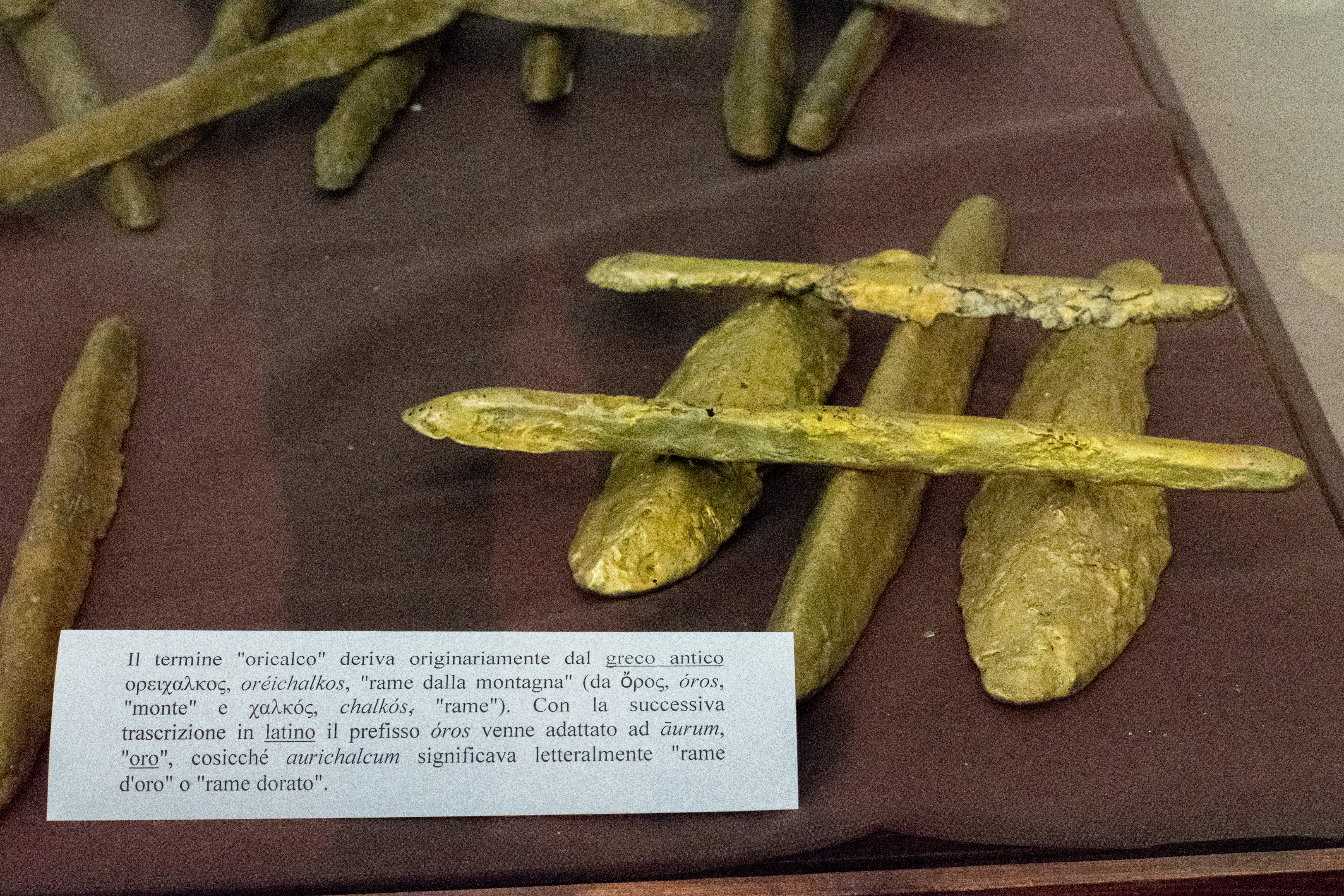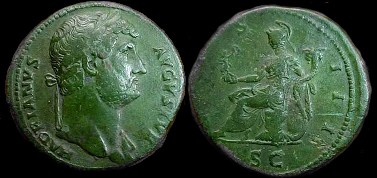|
Double Sestertius
The double sestertius was a large Roman coin made of orichalcum (brass) first issued by Trajan Decius in AD 249–251, as a response to the inflationary pressures of the time which had devalued the buying power of the conventional sestertius. In reality the new coin was little bigger than the traditional sestertius, which by then was being manufactured at a lower weight and smaller size than it had originally been, and was not a success. The new coin fell out of use but was revived by the rebel emperor Postumus (259–268), who ruled a breakaway empire consisting of Britain, Gaul and parts of Germany, and was keen to associate his regime with a reformed coinage system. Postumus issued his own version of the double sestertius, often taking very worn old sestertii and using these to overstrike his own portrait and legends on, probably because of a shortage of metal. After his reign, the Roman coinage system degenerated further with almost the only circulating pieces being very deb ... [...More Info...] [...Related Items...] OR: [Wikipedia] [Google] [Baidu] |
Orichalcum
Orichalcum or aurichalcum is a metal mentioned in several ancient writings, including the story of Atlantis in the ''Critias'' of Plato. Within the dialogue, Critias (460–403 BC) claims that orichalcum had been considered second only to gold in value and had been found and mined in many parts of Atlantis in ancient times, but that by Critias's own time orichalcum was known only by name. Orichalcum may have been a noble metal such as platinum, as it was supposed to be mined, or one type of bronze or brass or possibly some other metal alloy. Overview The name is derived from the Greek , ' (from , ', mountain and , ', copper), meaning literally "mountain copper". The Romans transliterated "orichalcum" as "aurichalcum", which was thought to mean literally "gold copper". It is known from the writings of Cicero that the metal which they called orichalcum resembled gold in color but had a much lower value. In Virgil's ''Aeneid'', the breastplate of Turnus is described as "stif ... [...More Info...] [...Related Items...] OR: [Wikipedia] [Google] [Baidu] |
Brass
Brass is an alloy of copper (Cu) and zinc (Zn), in proportions which can be varied to achieve different mechanical, electrical, and chemical properties. It is a substitutional alloy: atoms of the two constituents may replace each other within the same crystal structure. Brass is similar to bronze, another copper alloy, that uses tin instead of zinc. Both bronze and brass may include small proportions of a range of other elements including arsenic (As), lead (Pb), phosphorus (P), aluminium (Al), manganese (Mn), and silicon (Si). Historically, the distinction between the two alloys has been less consistent and clear, and modern practice in museums and archaeology increasingly avoids both terms for historical objects in favor of the more general "copper alloy". Brass has long been a popular material for decoration due to its bright, gold-like appearance; being used for drawer pulls and doorknobs. It has also been widely used to make utensils because of its low melting ... [...More Info...] [...Related Items...] OR: [Wikipedia] [Google] [Baidu] |
Trajan Decius
Gaius Messius Quintus Traianus Decius ( 201 ADJune 251 AD), sometimes translated as Trajan Decius or Decius, was the emperor of the Roman Empire from 249 to 251. A distinguished politician during the reign of Philip the Arab, Decius was proclaimed emperor by his troops after putting down a rebellion in Moesia. In 249, he defeated and killed Philip near Verona and was recognized as emperor by the Senate afterwards. During his reign, he attempted to strengthen the Roman state and its religion, leading to the Decian persecution, where a number of prominent Christians (including Pope Fabian) were put to death. In the last year of his reign, Decius co-ruled with his son Herennius Etruscus, until they were both killed by the Goths in the Battle of Abritus. Early life and rise to power Gaius Messius Quintus Traianus Decius was an Illyrian born at Budalia, Illyricum, near Sirmium in Pannonia Inferior. [...More Info...] [...Related Items...] OR: [Wikipedia] [Google] [Baidu] |
Inflation
In economics, inflation is an increase in the general price level of goods and services in an economy. When the general price level rises, each unit of currency buys fewer goods and services; consequently, inflation corresponds to a reduction in the purchasing power of money. The opposite of inflation is deflation, a sustained decrease in the general price level of goods and services. The common measure of inflation is the inflation rate, the annualized percentage change in a general price index. As prices do not all increase at the same rate, the consumer price index (CPI) is often used for this purpose. The employment cost index is also used for wages in the United States. Most economists agree that high levels of inflation as well as hyperinflation—which have severely disruptive effects on the real economy—are caused by persistent excessive growth in the money supply. Views on low to moderate rates of inflation are more varied. Low or moderate inflation may be attri ... [...More Info...] [...Related Items...] OR: [Wikipedia] [Google] [Baidu] |
Sestertius
The ''sestertius'' (plural ''sestertii''), or sesterce (plural sesterces), was an Ancient Rome, ancient Roman Roman currency, coin. During the Roman Republic it was a small, silver coin issued only on rare occasions. During the Roman Empire it was a large brass coin. The name ''sestertius'' means "two and one half", referring to its nominal value of two and a half ''as (Roman coin), asses'' (a bronze Roman coin, singular ''as''), a value that was useful for commerce because it was one quarter of a denarius, a coin worth ten ''asses''. The name is derived from ''semis'', "half" and "tertius", "third", in which "third" refers to the third ''as'': the sestertius was worth two full ''asses'' and half of a third. English-language sources routinely use the original Latin form ''sestertius'', plural ''sestertii''; but older literature frequently uses ''sesterce'', plural ''sesterces'', ''terce'' being the English equivalent of ''tertius''. A modern shorthand for values in sestertii i ... [...More Info...] [...Related Items...] OR: [Wikipedia] [Google] [Baidu] |
Postumus
Marcus Cassianius Latinius Postumus was a Roman commander of Batavian origin, who ruled as Emperor of the splinter state of the Roman Empire known to modern historians as the Gallic Empire. The Roman army in Gaul threw off its allegiance to Gallienus around the year 260,The year of Postumus' accession was either 259 or 260. In the past, the year 259 was favoured; today, however, most scholars consider that the summer or fall of 260 is the more likely date that he was hailed emperor, according to and The ''terminus ante quem'' is an inscription from September 260 naming Postumus as emperor: Bakker (1993), pp. 369–386. Other dates cited in this article must be pushed back one year for those who take 259 as the year of Postumus' accession. See . and Postumus assumed the title and powers of Emperor in the provinces of Gaul, Germania, Britannia and Hispania. He ruled for the better part of ten yearsBased on numismatic evidence, Postumus' rule extended over ten periods of tribun ... [...More Info...] [...Related Items...] OR: [Wikipedia] [Google] [Baidu] |
Overstrike (numismatics)
In numismatics, an overstrike describes a situation in which an existing coin rather than a blank is struck with a new design. This practice is now obsolete and generally occurred for two purposes. Overstriking was sometimes done for technical reasons when a first strike is unsatisfactory, or accidentally if the blank slips out of place or if the dies judder, resulting in a slight doubling of the design. However, sometimes old or worn coins were overstruck with new designs by later rulers or foreign states. In the ancient world, use of overstrikes was not uncommon, since the manufacture of flans was resource consumptive; thus a foreign or outdated coin could be overstruck with less investment than new mintage. Evidence of overstriking appears as early as about 500 BC when coins of Aegina were overstruck by the ancient city of Kydonia on Crete. In this case and many others, the overstrike can be a valuable aid to dating an ancient coin, an era when dates were not commonly affi ... [...More Info...] [...Related Items...] OR: [Wikipedia] [Google] [Baidu] |
Antoninianus
The ''antoninianus'' or pre-reform radiate, was a coin used during the Roman Empire thought to have been valued at 2 denarii. It was initially silver, but was slowly debased to bronze with a minimal silver content. The coin was introduced by Caracalla in early 215 AD. It was silver, similar to the denarius except that it was slightly larger and featured the emperor wearing a radiate crown, indicating it was a double denomination. Antoniniani depicting women (usually the emperor's wife) featured the bust resting upon a crescent moon. Even at its introduction, the silver content of the antoninianus was only equal to 1.5 denarii. This created inflation: people rapidly hoarded the denarii (Gresham's law), while both buyers and sellers recognized the new coin had a lower intrinsic value and elevated their prices to compensate. Silver bullion supplies began running short because the Roman Empire was no longer conquering new territory, the Iberian silver mines had been e ... [...More Info...] [...Related Items...] OR: [Wikipedia] [Google] [Baidu] |
Radiate Crown
A radiant or radiate crown, also known as a solar crown, sun crown, Eastern crown, or tyrant's crown, is a crown, wreath, diadem, or other headgear symbolizing the sun or more generally powers associated with the sun. Apart from the Ancient Egyptian form of a disc between two horns, it is shaped with a number of narrowing bands going outwards from the wearer's head, to represent the rays of the sun. These may be represented either as flat, on the same plane as the circlet of the crown, or rising at right angles to it. History In the iconography of ancient Egypt, the solar crown is taken as a disc framed by the horns of a ram or cow. It is worn by deities such as Horus in his solar or hawk-headed form, Hathor, and Isis. It may also be worn by pharaohs. In Ptolemaic Egypt, the solar crown could also be a radiate diadem, modeled after the type worn by Alexander the Great (as identified with the sun god Helios) in art from the mid-2nd century BC onward. It was perhaps influen ... [...More Info...] [...Related Items...] OR: [Wikipedia] [Google] [Baidu] |








.jpg)